
Crayfish are freshwater crustaceans resembling small lobsters. In some parts of the United States, they are also known as crawfish, craydids, crawdaddies, crawdads, freshwater lobsters, mountain lobsters, mudbugs, or yabbies. Taxonomically, they are members of the superfamilies Astacoidea and Parastacoidea. They breathe through feather-like gills. Some species are found in brooks and streams, where fresh water is running, while others thrive in swamps, ditches, and paddy fields. Most crayfish cannot tolerate polluted water, although some species, such as Procambarus clarkii, are hardier. Crayfish feed on animals and plants, either living or decomposing, and detritus.

Lobsters are a family of large marine crustaceans.
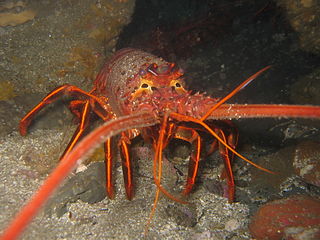
Spiny lobsters, also known as langustas, langouste, or rock lobsters, are a family (Palinuridae) of about 60 species of achelate crustaceans, in the Decapoda Reptantia. Spiny lobsters are also, especially in Australia, New Zealand, Ireland, South Africa, and the Bahamas, called crayfish, sea crayfish, or crawfish, terms which elsewhere are reserved for freshwater crayfish.
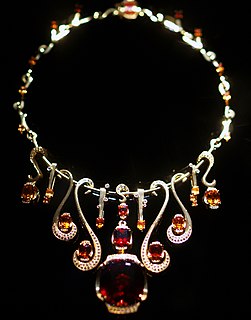
A necklace is an article of jewellery that is worn around the neck. Necklaces may have been one of the earliest types of adornment worn by humans. They often serve ceremonial, religious, magical, or funerary purposes and are also used as symbols of wealth and status, given that they are commonly made of precious metals and stones.
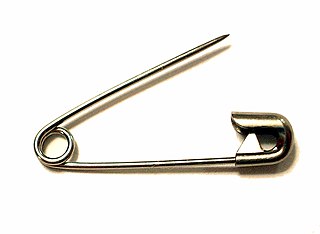
The safety pin is a variation of the regular pin which includes a simple spring mechanism and a clasp. The clasp serves two purposes: to form a closed loop thereby properly fastening the pin to whatever it is applied to, and to cover the end of the pin to protect the user from the sharp point.
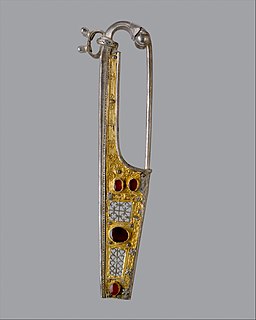
A brooch is a decorative jewelry item designed to be attached to garments, often to fasten them together. It is usually made of metal, often silver or gold or some other material. Brooches are frequently decorated with enamel or with gemstones and may be solely for ornament or serve a practical function as a clothes fastener. The earliest known brooches are from the Bronze Age. As fashions in brooches changed rather quickly, they are important chronological indicators. Many of the ancient European brooches found in archaeology are usually referred to by the Latin term fibula.

The American lobster is a species of lobster found on the Atlantic coast of North America, chiefly from Labrador to New Jersey. It is also known as Atlantic lobster, Canadian lobster, true lobster, northern lobster, Canadian Reds, or Maine lobster. It can reach a body length of 64 cm (25 in), and a mass of over 20 kilograms (44 lb), making it not only the heaviest crustacean in the world, but also the heaviest of all living arthropod species. Its closest relative is the European lobster Homarus gammarus, which can be distinguished by its coloration and the lack of spines on the underside of the rostrum. American lobsters are usually bluish green to brown with red spines, but several color variations have been observed.

Homarus gammarus, known as the European lobster or common lobster, is a species of clawed lobster from the eastern Atlantic Ocean, Mediterranean Sea and parts of the Black Sea. It is closely related to the American lobster, H. americanus. It may grow to a length of 60 cm (24 in) and a mass of 6 kilograms (13 lb), and bears a conspicuous pair of claws. In life the lobsters are blue, only becoming "lobster red" on cooking. Mating occurs in the summer, producing eggs which are carried by the females for up to a year before hatching into planktonic larvae. Homarus gammarus is a highly esteemed food, and is widely caught using lobster pots, mostly around the British Isles.

A fastener or fastening is a hardware device that mechanically joins or affixes two or more objects together. In general, fasteners are used to create non-permanent joints; that is, joints that can be removed or dismantled without damaging the joining components. Welding is an example of creating permanent joints. Steel fasteners are usually made of stainless steel, carbon steel, or alloy steel.

Squat lobsters are dorsoventrally flattened crustaceans with long tails held curled beneath the cephalothorax. They are found in the two superfamilies Galatheoidea and Chirostyloidea, which form part of the decapod infraorder Anomura, alongside groups including the hermit crabs and mole crabs. They are distributed worldwide in the oceans, and occur from near the surface to deep sea hydrothermal vents, with one species occupying caves above sea level. More than 900 species have been described, in around 60 genera. Some species form dense aggregations, either on the sea floor or in the water column, and a small number are commercially fished.

Porcelain crabs are decapod crustaceans in the widespread family Porcellanidae, which superficially resemble true crabs. They have flattened bodies as an adaptation for living in rock crevices. They are delicate, readily losing limbs when attacked, and use their large claws for maintaining territories. They first appeared in the Tithonian age of the Late Jurassic epoch, 145-152 million years ago.
Stretching, in the context of body piercing, is the deliberate expansion of a healed piercing for the purpose of wearing certain types of jewelry. Ear piercings are the most commonly stretched piercings, with nasal septum piercings, tongue piercings and lip piercings/lip plates following close behind. While all piercings can be stretched to some degree, cartilage piercings are usually more difficult to stretch and more likely to form hypertrophic scars if stretched quickly. Dermal punching is generally the preferred method for accommodating larger jewelry in cartilage piercings.

A chatelaine is a decorative belt hook or clasp worn at the waist with a series of chains suspended from it. Each chain is mounted with useful household appendages such as scissors, thimbles, watches, keys, vinaigrette, and household seals.

A bear claw is a sweet, yeast-raised pastry, a type of Danish, originating in the United States during the mid-1920s. In Denmark a bear claw is referred to as kamme. The name bear claw as used for a pastry is first attested in 1936. The phrase is more common in Western American English, and is included in the U.S. Regional Dialect Survey Results, Question #87, "Do you use the term 'bear claw' for a kind of pastry?"

The family Polychelidae contains thirty-eight extant species of blind, benthic lobster-like crustaceans. They are found throughout the world's tropical, sub-tropical and temperate oceans, including the Mediterranean Sea and the Irish Sea.

Ibacus peronii, the Balmain bug or butterfly fan lobster, is a species of slipper lobster. It lives in shallow waters around Australia and is the subject of small-scale fishery. It is a flattened, reddish brown animal, up to 23 cm (9 in) long and 14 cm (6 in) wide, with flattened antennae and no claws.

A belly chain or waist chain is the popular English term for the South Asian jewellery called Kamarband (Hindi) (कमरबंद) or (Udiyanam) (Tamil) (உடையன). The belly chain is a type of body jewelry worn around the waist. Some belly chains attach to a navel piercing; these are also called "pierced belly chains". They are often made of silver or gold. Sometimes a thread is used around the waist instead of a chain. The belly chains can be delicate thin or heavy thick.

Wire wrapping is one of the oldest techniques for making handmade jewelry. This technique is done with jewelry wire and findings similar to wire to make components. Wire components are then connected to one another using mechanical techniques with no soldering or heating of the wire. Frequently, in this approach, a wire is bent into a loop or other decorative shape and then the wire is wrapped around itself to finish the wire component. This makes the loop or decorative shape permanent. The technique of wrapping wire around itself gives this craft its name of wire wrapping.

Bling-bling, often shortened to just bling, is "flashy jewelry worn especially as an indication of wealth or status; broadly: expensive and ostentatious possessions" such as grills and designer bags. The term arose as localized slang, but grew into a cultural mainstay. Prominent examples of bling-bling include a large cross necklace or Jesus piece.
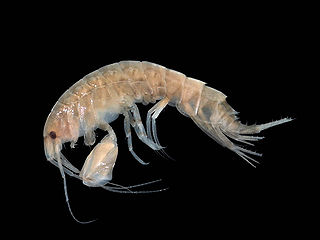
Crustaceans form a large, diverse arthropod taxon which includes such animals as crabs, lobsters, crayfish, shrimps, prawns, krill, woodlice, and barnacles. The crustacean group can be treated as a subphylum under the clade Mandibulata; because of recent molecular studies it is now well accepted that the crustacean group is paraphyletic, and comprises all animals in the clade Pancrustacea other than hexapods. Some crustaceans are more closely related to insects and the other hexapods than they are to certain other crustaceans.


















